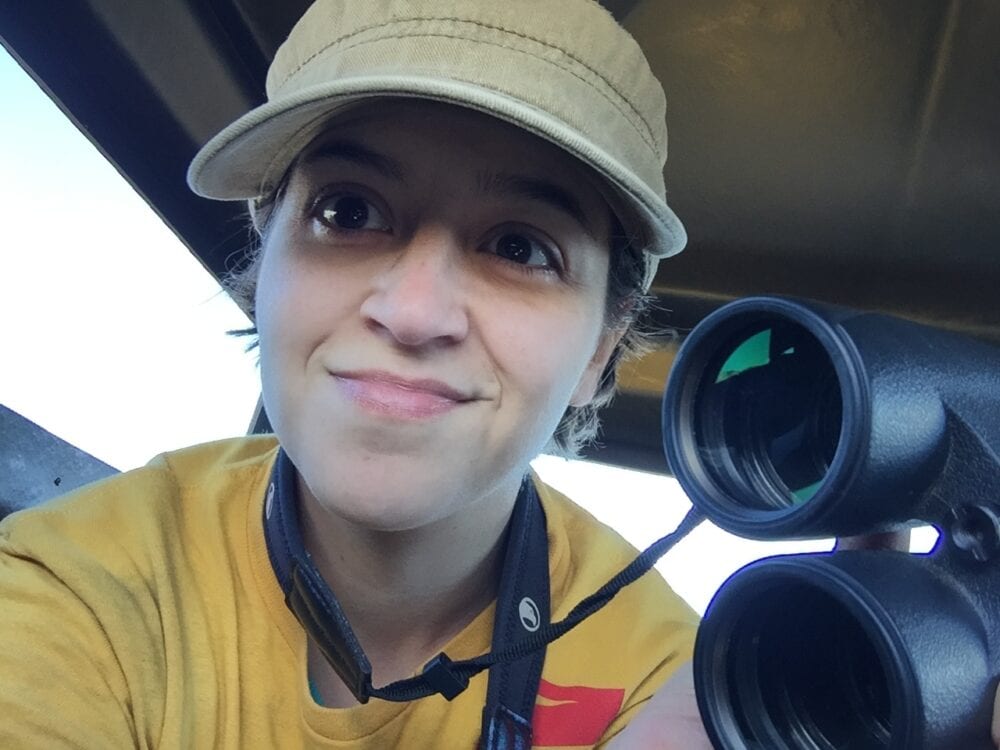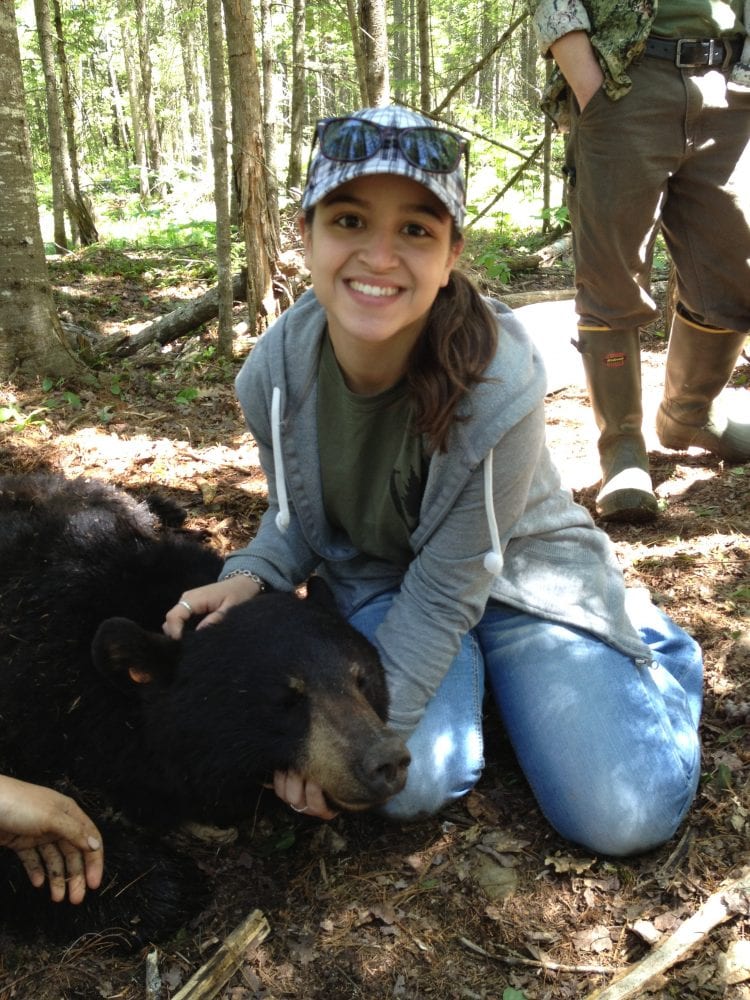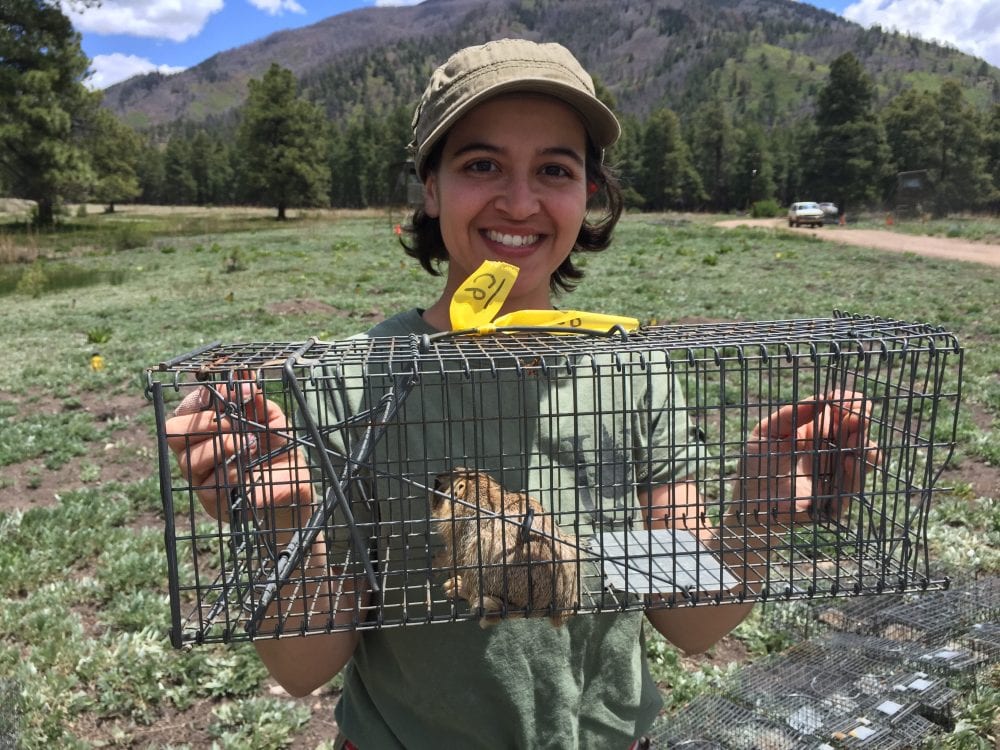Mariana Rivera Freeman is the first New Mexico Naturalist in this new monthly series from the Pajarito Environmental Education Center. We hope you’ll enjoy learning about her and her work. Along with this interview, Mariana gave a talk on her experiences studying the Gunnison’s prairie dog in Valles Caldera National Preserve. If you missed it, watch it here.
Location: Los Alamos, NM
Occupation: Field Science Specialist at the Pajarito Environmental Education Center
Favorite Place in NM: Redondo Meadow in Valles Caldera National Preserve
Favorite NM Critter: Gunnison’s Prairie Dog
Mariana Rivera Freeman started loving nature when visiting family in Puerto Rico in her childhood. She spent hours outside with her sisters and cousins exploring the plants around her grandparents’ home. She remembers one plant, the morivivi, truly sparked her curiosity about the natural world. The plant’s name comes from the Spanish words morir and vivir, meaning to die and to live. When you touch the plant, it folds in on itself, and then reopens.
“Seeing a plant that moved so immediately was like magic to me,” Mariana says. “Plants can be kind of static unless there’s wind. So, it made the plant seem like it had a personality. It just really sparked my imagination.”
Now, Mariana is the Field Science Specialist and an educator at the Pajarito Environmental Education Center. Prior to that, she work at Valles Caldera National Preserve for three years studying prairie dogs.
How would you define a “naturalist”?
For me, the only requirement to be a naturalist is just an appreciation of nature. You don’t have to know what you’re looking at, but if it sparks curiosity in you, I think you’re automatically a naturalist. I think there’s a spectrum. You can be a casual naturalist, you can be an expert naturalist, but most of us fall somewhere in between.
I also think you can be a naturalist indoors or outdoors. If you have a plant indoors and you take care of it, think about it, and explore it, that’s just as important as being out in the wild.
How do you connect with nature in your life or work today?
Every morning when I take my dog out, I sit in a hammock for awhile. I have a gathered end Puerto Rican hammock that I like to sit in. It’s really nice, so I’ll just spend my mornings there, just kind of with no distractions while my dog is wandering around. It’s kind of meditative. I might read some poetry or do things like that while I’m outside.
I actually suffer from major depression. I try to be open about it because I think it’s really important for people to get out in nature when they suffer from depression. It’s really healing, so I try to deliberately go out there and sit in the hammock. It’s more recent that I’ve taken some poetry out there and tried to recite poetry. Some people will pray when they’re in nature, but I like to recite poetry.
I also like hiking and going to the Jemez as often as I can. When the nature center was open and hosting field trips, I enjoyed taking kids out in nature as a part of my job.

What word makes you feel most at home when you think about nature?
I’ve been trying more recently to embrace “the land.” We’re pretty settled now in New Mexico and I used to move around a lot. I never felt a particular connection to the land before. Home was always family to me. We were really tight knit, so everywhere we went, it was really just the family that was home.
When we settled in Los Alamos, I started to feel this desire to get to know the land more. The Jemez Mountains are really special to me now and I’ve just been trying to embrace land as home.
What are your hopes or concerns for the future for nature in New Mexico?
My biggest concern since I moved to the Southwest has always been water. Global water conflict is always something that I’ve kept an eye on. When I talk to kids about water, I always try to tell them that it’s a resource that we should share. It belongs to no one and it belongs to everyone and you have to respect both sides of that coin.
With accelerated climate change, water is gradually becoming more scarce in the Southwest and its availability is becoming less and less reliable. Wildlife have difficulty accessing water to the point where they will die if they can’t get enough water, so we have to be cognizant of that. We also have to be cognizant of how water matters to different cultures and the history of water use and of taking water. The more we know about it, the easier it is to share water.
What are your hopes for the next generation of New Mexico children?

You see a lot of vitriol out there right now and a lot of it is disagreements over science, like the science of coronavirus and the science of climate change. The great thing about kids is that there’s really a general lack of vitriol, they’re not at that point in their lives where they’re full of anger. It’s great to tap into that. Children have a way of finding truth in facts, but also finding truth in imagination, empathy, and even whimsy. I think if you can tap into those things for kids, recognize them, and really cultivate them, there’s definitely a lot more hope for society and for the planet if you can keep that alive in children.
I always say that facts are not going to save the world. Facts are important, but I think they are really kind of impotent when you present them without being empathetic toward people, especially without understanding culture and cultural differences. Childhood is a perfect time to really instill that facts and empathy go together and you can’t just depend on the truth of facts when you don’t recognize the truth of culture or the truth of traditions or the truth of empathy.
Anything you would like to add?
In wildlife, I encounter a lot of my peers in the field have difficulty communicating science because we are empathetic toward nature, but sometimes we don’t reserve that empathy toward people and I feel like as conservationists we need to do that more. Culture and tradition don’t take kindly to insult. When we call people idiots because they deny science, it’s just so counterproductive.
The way you treat nature is intrinsically linked to the way you treat people. They come together and if you reserve all of your empathy for nature without leaving some for people, then you’re doing everybody a disservice. People are part of nature, so everything we do to nature affects people, whether directly or indirectly, and vice versa.
Learn more about Mariana’s research on Gunnison’s prairie dogs on this website, which she maintained alongside her mentor, John Hoogland.
New Mexico Naturalists is a monthly series produced by the Pajarito Environmental Education Center (PEEC) to highlight the work and experiences of people throughout the state that are making meaningful connections with nature and wildlife.
Have a suggestion for a naturalist that we should feature in the future? Email publicity@peecnature.org to let us know! PEEC is the non-profit organization that operates the Los Alamos Nature Center.


Unfortunately I cannot watch the online talk tonight with Mariana Rivera Freeman, but I am hoping it will be available on video later and accessible from PEEC’s website.
I would like to ask her if prairie dogs, when they come into an urban setting to build their colony, act differently then when they are in the wild. Taos has some expanding prairie dog colonies in the town that often become problematic. What are her thoughts on this? Does she have any solutions for these situations where prairie dogs grow large colonies in close contact with residential neighborhoods?
Thanks